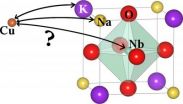New disease-resistant food crops in prospect
2010-11-19
(Press-News.org) Researchers have uncovered the genetic basis of remarkable broad-spectrum resistance to a viral infection that, in some parts of the world, is the most important pathogen affecting leafy and arable brassica crops including broccoli, cauliflower, cabbage, kale, swede and oilseed rape. They have tested resistant plants against a range of different strains of the virus taken from all over the world and so far, no strain has been able to overcome the resistance.
The research on the so-called Turnip mosaic virus (TuMV), led by Dr John Walsh of the University of Warwick and funded under the BBSRC Crop Science Initiative, has been taken forward in a new partnership with Syngenta Seeds.
Dr Walsh said "TuMV causes really nasty-looking black necrotic spots on the plants it infects - 'a pox on your' vegetables! This can cause significant yield losses and often leaves an entire crop unfit for marketing. At best, a field of badly affected Brussels sprouts might provide some animal fodder, but these vegetables would not be appealing to most shoppers. The virus is particularly difficult to control because it is transmitted so rapidly to plants by the insect vectors"
Dr Walsh and his team identified the major gene involved in resistance to TuMV and discovered that the way in which it creates resistance is completely new. Using this knowledge, they found that it was possible to identify plants with an inherent resistance that could be used to speed up the breeding process and develop commercial varieties that are resistant to TuMV.
The team from University of Warwick are now working with industry partner Syngenta Seeds to breed resistance into Chinese cabbage. They hope in future to do the same with other crops such as broccoli, cabbage and kale.
Peter van der Toorn, R&D Lead Leafy Crops, Syngenta Seeds Vegetables said "Working in partnership with academic researchers is very important for us. Through such collaborations it's possible to take an idea from pre-commercial research and turn it into a new variety that can benefit the consumer and boost our contribution to the UK economy. We are very excited to be working together with academics at the University of Warwick to breed varieties with improved resistance to Turnip mosaic virus."
Professor Douglas Kell, BBSRC Chief Executive said "Bioscience research in all its forms has always given rise to developments that have impacts in society – whether predicted or serendipitous. Such developments need a structure through which to realise their potential and a partnership such as this one between the University of Warwick researchers and Syngenta will be important to ensure that resistance to diseases is incorporated into commercial crop varieties. These new resistant varieties would then be available to contribute towards future food security."
INFORMATION: END
ELSE PRESS RELEASES FROM THIS DATE:
2010-11-19
The transplant community was largely unaware of sub-standard transportation practices for donor organs until a number of fatal air crashes took the lives of transplant personnel, calling attention to procurement aviation safety. A new report highlighting the need for improved safety measures in organ procurement travel appears in the December issue of Liver Transplantation, a peer-reviewed journal published by Wiley-Blackwell on behalf of the American Association for the Study of Liver Diseases (AASLD).
In the U.S., the Organ Procurement and Transplantation Network (OPTN) ...
2010-11-19
OAKLAND, Calif. – Compared to women never on hormone therapy, those taking hormone therapy only at midlife had a 26 percent decreased risk of dementia; while women taking HT only in late life had a 48 percent increased risk of dementia, according to Kaiser Permanente researchers.
Women taking HT at both midlife (mean age 48.7 years) and late life had a similar risk of dementia as women not on HT, according to the study which appears in the Annals of Neurology. The study was funded in part by the National Institutes of Health.
Although previous research has shown that ...
2010-11-19
A protein known to exist in the brain for more than 30 years, called 5-lipoxygenase, has been found to play a regulatory role in the formation of the amyloid beta in the brain, the major component of plaques implicated in the development of Alzheimer's disease, according to researchers at Temple University's School of Medicine.
The researchers also found that inhibitors of this protein currently used to control asthma could possibly be used to prevent or treat Alzheimer's disease.
The researchers published their findings, "5-Lipoxygenase as Endogenous Modulator of Amyloid ...
2010-11-19
Retinitis pigmentosa is an inherited eye disorder characterized by progressive loss of vision that in many instances leads to legal blindness at the end stage.
In a ChIP-Seq based approach, the researchers identified a key regulatory role of the transcription factor Crx (Cone-rod homeobox) in the expression of retina-specific genes and thus described an important genetic basis for visual perception. In-depth analysis of Crx mediated regulation in photoreceptors with latest technology provided by Genomatix lead then to the identification of nonsense mutations in the human ...
2010-11-19
New stars are born in the Universe around the clock – on the Milky Way, currently about ten per year. From the birth rate in the past, we can generally calculate how populated space should actually be. But the problem is that the results of such calculations do not match our actual observations. "There should actually be a lot more stars that we can see," says Dr. Jan Pflamm-Altenburg, astrophysicist at the Argelander-Institut für Astronomie of the University of Bonn.
So, where are those stars?
For years, astronomers worldwide have been looking for a plausible explanation ...
2010-11-19
The casting sessions aren't just for movie stars, but what is involved in casting decisions that can launch fashion models to fame – or at the very least – to land a job? Stephanie Sadre-Orafai, a University of Cincinnati assistant professor and socio-cultural anthropologist, spent 11 months of fieldwork at a premiere casting agency in New York to uncover the decisions that happen behind the scenes of the glossy photos and slick commercials. Her research, "Polaroids and Go-Sees: Casting Encounters, Casting Epistemologies," was presented Nov. 17 at the 109th annual meeting ...
2010-11-19
HOUSTON – (Nov. 18, 2010) – Discovery of a fifth gene defect and the identification of 47 DNA regions linked to thoracic aortic disease are the subject of studies released this month involving researchers at The University of Texas Health Science Center at Houston (UTHealth).
In both studies, the investigators have identified alterations in the genetic material or DNA that affect the ability of smooth muscle cells, which line the aorta and other blood vessels, to contract. This can lead to a weakening of the wall of the aorta, the main blood vessel leading out of the ...
2010-11-19
Technical progress in the automobile industry is unbroken. But, the sector has still some hard nuts to crack: "Lead-free materials" is one of the challenges – hidden behind this challenge is a EU environmental directive which, based on a step-by-step plan, gradually bans all lead-containing materials and components from automotive vehicles – such as piezoelectric components. These elements are important for diesel engine injectors, for example, which control the supply of fuel to the combustion chamber.
The problem: Up to now lead-zirconate-titanate (PZT) is the material ...
2010-11-19
A short push on the light switch – and the whole ceiling lights up in a uniform and pleasant color. This "illuminated sky" is not available as yet, but researchers from all over the world are working on it flat out. The technology behind this marvel is based on organic light-emitting diodes, or OLEDs for short. These diodes use special molecules to emit light as soon as current passes through them. Although the first OLEDs have only recently become available, they are small and expensive. A flat disk with a diameter of eight centimeters costs around Euro 250. Experts of ...
2010-11-19
Scientists at Johns Hopkins have identified a compound that could be used to starve cancers of their sugar-based building blocks. The compound, called a glutaminase inhibitor, has been tested on laboratory-cultured, sugar-hungry brain cancer cells and, the scientists say, may have the potential to be used for many types of primary brain tumors.
The Johns Hopkins scientists, are inventors on patent applications related to the discovery, caution that glutaminase inhibitors have not been tested in animals or humans, but their findings may spark new interest in the glutaminase ...
LAST 30 PRESS RELEASES:
[Press-News.org] New disease-resistant food crops in prospect

